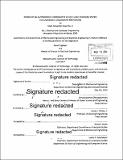Design of an Autonomous Underwater Vehicle (AUV) charging system for underway, underwater recharging
Author(s)
Ewachiw, Mark Alexander, Jr
DownloadFull printable version (15.87Mb)
Other Contributors
Massachusetts Institute of Technology. Department of Mechanical Engineering.
Advisor
Chryssostomos Chryssostomidis.
Terms of use
Metadata
Show full item recordAbstract
Modern robotics have enabled the rapid proliferation of Autonomous Underwater Vehicles (AUVs) throughout the marine environment. As autonomy algorithms increase in robustness, complexity, and reliability, so too does the ability of AUVs to perform an even-increasing array of complex missions. Maritime tasks that once required a fleet of ships, months to complete, and numerous mariners are now being performed by AUVs with little to no logistical support elements. Despite the many AUV technology advances that have been made, power remains a limiting factor. Most AUVs use onboard stored electric energy and electric drive to perform their various missions. The current method for deploying this type of AUV requires charging it above water, shipping it to a mission site, and then deploying it overboard with the use of cranes. The AUV is then recovered once the mission is complete or - more likely - when its power source is depleted. The deployment and recovery phases are time-intensive, limited by weather conditions and sea state, and often hazardous to both crew and AUV. While deployment and recovery will remain critical, high-risk evolutions, there exists a need to find a safer and faster recharging method that does not require recovery of the vehicle. This thesis addresses a fraction of the underwater AUV power transfer and rapid charging challenge through the development of the power electronics required to reliably charge a single battery pack. Power is supplied inductively to a receiver coil in the AUV. This power is then transferred to a down converter with a current-sensing feedback controller to provide a regulated current under the varying load voltage of the battery pack. The system is capable of providing up to 500W of instantaneous power to a single pack. It is electrically isolated from the power source through the use of an input transformer and is compact enough to be integrated into an AUV for future testing.
Description
Thesis: S.M., Massachusetts Institute of Technology, Department of Electrical Engineering and Computer Science, 2014. Thesis: Nav. E., Massachusetts Institute of Technology, Department of Mechanical Engineering, 2014. Cataloged from PDF version of thesis. "June 2014." Includes bibliographical references (pages 83-84).
Date issued
2014Department
Massachusetts Institute of Technology. Department of Electrical Engineering and Computer Science; Massachusetts Institute of Technology. Department of Mechanical EngineeringPublisher
Massachusetts Institute of Technology
Keywords
Electrical Engineering and Computer Science., Mechanical Engineering.